If we ever colonize Mars, our settlements will look a lot like Santee Town Center.
The heart of Santee, CA, on San Diego’s eastern edge, is a series of interlocking strip malls, the big box monster kind, abutted with parking lots vast enough to accommodate a jetliner. It is almost totally artificial: palm trees line the trolley tracks which lead to the fountain which is the mall’s sort of centre, and planted deciduous trees sort of shelter the pavement between the parking bays. Behind the hangar-like rooftops are the desert hills, bony and red-brown in color, which constitute the real southern California. Blink once, twice, and you can imagine the mall as a series of bunkers clamped down on the surface of an alien planet. All it needs is a glass dome.
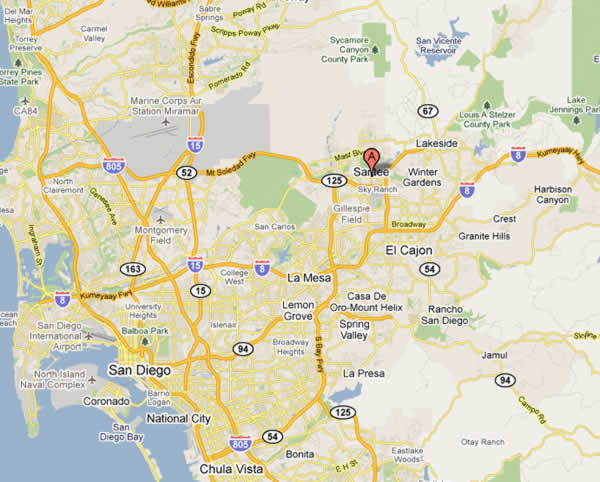
I was raised in a series of western Canadian small towns with Main streets and family businesses, and even if people liked their vehicles, you could still walk everywhere, and most people did. For most of my adult life, I’ve lived in big cities, where the car is largely unnecessary, even inconvenient and I don’t usually like malls. I don’t like cars, or car culture. But for a few days at least, I thoroughly enjoyed Santee.
Part of it was the oddity of being in Southern California for Christmas. I was out with my girlfriend to see her sister, who lives in the area. Terrible storms had lashed the area the week before we arrived, triggering landslides and floods, but the rest of the time it was sun and more sun. Cut-out Santas leaned against dusty palm trees, Christmas lights decorated lawns that would never know snow. Christmas music blared over every parking lot and store, oblivious to both sunshine and desert.
Part of it was the seeing ‘American Graffiti’ for the first time in many years, shortly before we went West, which made me both curious about small city California, and homesick. I hadn’t been West in many years, and even when I had gone back, the landscape had changed so much I hardly recognized it. One of the towns I grew up in is abandoned; others have morphed or been absorbed by ex-urban miasmas like Santee. I wanted to find some echo of small town life, the North America away from the big city.

Part of it was Santee’s setting, which is spectacular, winding through a broad valley with those desert hills on either side. Parks break up the residential areas, some man-made with flowering trees and lakes, most carved out of desert, with house-sized boulders and flowering cacti. The sunsets are pink, yellow, purple; unlike any I’ve ever seen, and in the morning it was often foggy, the fog lying over the valley. Walking up the hill behind our host’s house, I felt like I’d climbed right into the stratosphere.
Santee is certainly a peculiar place, even by California standards. The land might have been spectacular, but most of it seemed to be fenced off, so aside from the parks you couldn’t just walk out into open country. I never found out why. Santee is the wealthiest town in East County, the mayor a tea party man. Many years ago, it was mostly farmland, and locals welcomed the mall, since it gave them somewhere to go. Once, Santee had been nicknamed ‘Klantee’ because of the white power/ skinhead activity in the area but I didn’t see anything like that. Our area near the highway seemed largely low income, with many Mexican families. A man down the street had lost his job and moved in with his mother, his battered Ford Explorer rarely left the driveway. A couple of houses down the street had been foreclosed, and sat empty, and further on a couple of blocks of duplexes had been turned over to Chapter 8 housing. The wealth was up in the hills, on lots carved out of the desert, in huge McMansions stacked up on the bluffs like great glass pillboxes.
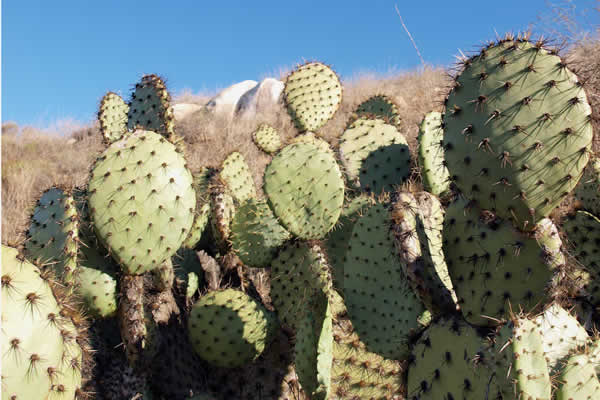
Vehicle noise echoed through the valley, ebbing at night, picking up at dawn, the sound you both fell asleep and woke up to. At night, walking up the hill, I would climb out of the streetlights into a breathtaking star-scape, yet the highway was ever-present, glittering far below, its hum filling the ears like the gritty din of a churning factory. A drive-in theatre sat at the bottom of the valley, the images on the screen visible from the hill, but no cars ever seemed to be in it.
Not far from the mall were a cluster of bail bond centres, open 24 hours a day, servicing the prison a mile up the road. George “King” Stahlman, a kind of bail bond magnate (Slogan: “it’s better to know me and not need me than need me and not know me.”) had been a local celebrity: bail bonds, it seems, are big business. A gun show had wrapped up the day we arrived, with all manner of lethal weaponry laid out on tables in a warehouse like goods in a flea market. And across the highway, in an anonymous light industrial complex, was a blue and white sign announcing a ‘Museum of Creation and Earth History’.
Despite the supremacy of the car, Santee was a great place to ride a bike. Drivers were courteous, their actions predictable, and the bike lanes ran along trunk roads and lesser highways, behind the malls and along the river out to the edge of the fenced off hills and desert parks. Detritus from the flooding was everywhere: toppled palm trees lay across the river, and mud and refuse washed through the lower-lying parks, the golf course. And yet, out in the open, I had a sense of the legendary California vastness. The West I was raised in may have been far less populated than this one, but Canada’s frontier is constrained by the cold, the caution and prosaic vision of our Scottish forebears. This was California, land of myth, the sometimes loopy, often magic place I’d been hearing about my whole life, where in the depths of winter you could ride right out into the desert with the great Western sky overhead, a place where, once, you could believe in becoming anything at all.
Some small section of that frontier lived on in the form of a windowless bar sequestered in one of the trunk road strip malls. The jukebox played mostly country, and in the parking lot was a dune buggy covered in the Stars and Stripes, owned by the bartender, a bear of a man regulars called Nascar. The bar never seemed to have more than a half-dozen patrons but they were friendly enough and I liked drinking there: even with a few people it was familiar, a real neighborhood bar, patronized by road workers, off-duty soldiers, local people, the kind of people I don’t see too much anymore in my regular life.
One night, Nascar and a few of his buddies talked about having a ‘clamp’. The music was loud and I wondered if they were saying ‘Klan’, but it turned out they were talking about some sort of off-roading club they’d started twenty years before, when they’d all moved down from various cities in the Northeast, part of the first great migration to the area. They recounted tying Clamp inductees to telephone poles in their underwear, dousing them with beer and leaving them out for an afternoon or Clamp legends like the guy who consumed beans all week leading up to a Clamp so he could let loose at the event; another buddy who owned a car service and had promised them one of his out of service cars so they could ride it into the ground. As they ordered pitcher after pitcher, their stories got funnier and more outrageous, until I was laughing out loud listening to them. Finally, one guy’s wife showed up with their son, who looked to be in his late teens. The wife was elegant looking and kissed Nascar on the cheek like they’d all been friends for years, but the kid hung out near the door, keeping his distance from his Dad and his crazy redneck friends. He wore black jeans and a dark shirt and I thought of how many urban hipster kids start out like this, desperate for an identity away from places like Santee.
I started talking to one of the other regulars. Like the others, he’d moved down from the Northeast 20 years before. He said times were hard, that the bar was struggling. “This is a working man type of place, and no one can afford to come and drink anymore.” He’d had trouble with skinheads years before, even had to pull a gun once, and if it wasn’t for his parents, who’d retired in the area, he’d move to Arizona “where they left you alone.” I wasn’t sure what he meant until he began telling me about his gun collection, going into exhaustive detail like some model train enthusiast. Even if I was raised in a hunting culture, and still have friends who hunt (and eat what they hunt), I’ll never get the America obsession with the gun.
Back at the mall, the trolley left Trolley Square, the station next to the fountains, the Army recruiting center, weaving through magnificent hills and valleys into San Diego proper and continuing through downtown along the shoreline where aircraft carriers leaned from the water like colossal hi-rises, right to the Mexican border. Across the river was Tijuana, where thousands have died in drug-fuelled gang wars, yet the Mexicans getting on the trolley returning North looked relaxed, even happy. Downtown, amidst the movie set buildings and plentiful bars, one saw the recession’s full affect in the masses of homeless – white, black, Hispanic, young and old – sleeping under the palm trees, taking over a park, queuing for a makeshift soup kitchen on the street corner.
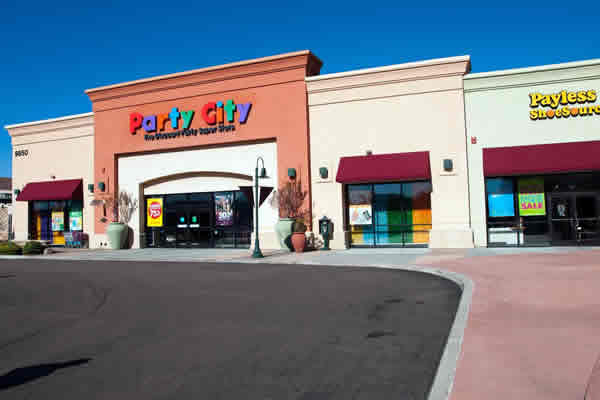
But none of that came out to the mall. Despite the wealth up on the hills, Santee Town Center was a mid-level strip mall – TJ Maxx, Barnes and Noble, Pizza Hut; an Old Navy but no Banana Republic. I went to Starbucks in the morning and sometimes, for a change from the strip mall bar, to a sports bar where they served excellent California pizza and even more excellent California draught beer. The mall parking lot was full of SUVs, some of them jacked up for off-roading, but mostly old Ford Explorers, bus-sized Navajos and fleets of identical white pickups. Sometimes you’d even see Truck Nutz, those hard plastic testicles people hang from the backs of their trucks to show . . .I don’t know what they show. But people were friendly, saying hello, and the local Starbucks was a convivial and relaxed place to spend an hour or so. The same people hung out day after day, morning and afternoon, sitting around the patio tables, hunkered down in the sofa chairs, books piled up beside them. A man in his 20’s, who I later found out lived in his car, listening attentively while a middle-aged lady told him about her Smurf collection, a grey haired couple in blue and white track suits perusing the magazines in the Barnes and Nobles next door. A big kid with a shaved head and tattoos, maybe twenty or so, leftover or maybe a representative of those infamous Santee skinheads, chatting to a couple of girls his age or younger about his kids, their kids, muttering darkly about black kids running wild in San Diego. Next door in Trolley Square, a punk rock girl with a bleached blonde Mohawk danced to the Christmas music, kicking her booted feet in the air, while a pair of grizzled 50-somethings, man and woman, whizzed by in their wheelchairs, two Jolly Rogers flapping from the steel poles attached to the backs of their respective seats.
On Christmas Day, the mall shifted dimensions. Starbucks, like every other business, was closed, and the mall was deserted, the vast parking lots free of vehicles. The tables and chairs on the Starbucks’ patio had been left unchained, and the mall seemed to run on automatic, like Ray Bradbury’s futuristic house in ‘There Will Be Soft Rains’ which continues routine chores like making the breakfast and vacuuming the rugs long after its inhabitants have been annihilated in a nuclear attack. Christmas music blared from the loudspeakers, telling of reindeer, snowmen; Frank Sinatra and some of his favorite things. The trolley wheezed in and out of the station, empty. I wouldn’t have been surprised if an army of maintenance robots had rolled en masse out of the cavernous Party City to scrub the whole place down. Alone in that curious stillness, the desert hills visible in every direction, I felt like the mall was not so much an adjunct of the city as of the vast desert spaces sweeping off the hills into the badlands I’d seen through the plane window flying in. Maybe, I felt the mall IS the frontier, preparing us for that next and greatest frontier, the leap into space. Maybe these sunbelt exurb cities are the future of North American civilization, an escape from the half-abandoned or over-priced, over-gentrified cities of the Northeast.
The next day, out of curiosity, I went to the Creation Museum. I am mildly religious, and some of the old folks where I grew up had a hard time accepting that man is descended from apes: I hoped that the Museum might try, in however a clumsy way, to offer some spiritual alternative to scientific rationalism.
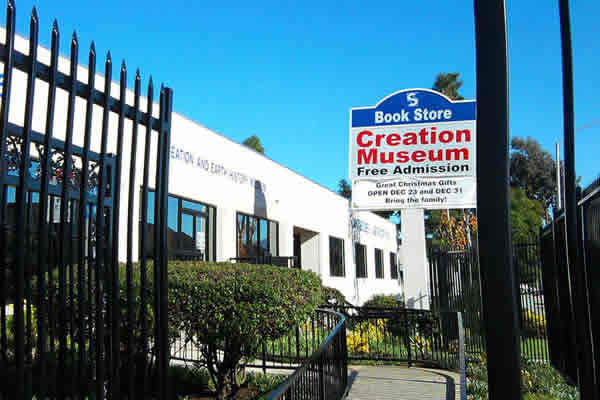
The complex was run by a light pharmaceutical company called, of all things, Scantibodies which, I read later, had taken over the museum a few years before and pumped a lot of money into it. Certainly, the lobby was slick, almost corporate, with a big front desk and tinted windows looking out on the highway. A bookstore with racks of well-bound books, kid’s toys and interactive models like you’d find in any museum sprawled out next to the lobby. The museum was well laid out, with professionally designed exhibits guiding the visitor through the universe’s history – all six thousand years of it. The exhibits explained that God had made each planet in our solar system separately, then showed how the sediments carbon-dated to prove the Earth’s age, were merely volcanic lava shot forth at high speeds, like at St. Helen’s. A glass case contained a blocky wooden model of Noah’s Ark; a hall way ran through a plastic glacier, illustrating theIce Age that resulted after the Great Flood. In another room, next to bland-looking models of Cro-Magnon men and Neanderthals, displays explained that these were actually modern humans, “just slightly more squat, with bigger foreheads – like Eskimos”, that ‘cavemen’ were not subhuman, but ‘weak, degenerate’ descendants of exiles from Babel. Next to reproductions of medieval prints showing St. George slaying a dragon, more text explained that dragons were actually dinosaurs, while charts showed how all religions except for Christianity grew out of Satanism, how evolutionary theory was descended from the fruit of the tree of evil.
Just before the exit came two walls, one showing ‘good’ scientists who had believed in the Christian God (though the exhibit didn’t state whether they were actually Creationists), the other showing evil evolutionists: Freud and Hitler, Darwin and Stalin. A last exhibit denounced the global warming theory as an evolutionist plot, explaining that while the Earth had indeed been warming since the early 19th century, this had nothing to do with man, but was part of God’s plan to, among other things, make travel easier by keeping the roads free of snow.
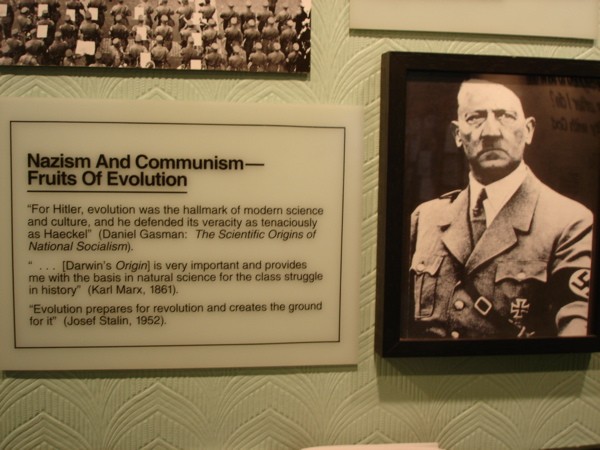
That museum depressed the hell out of me. Such absurd literalism. Such willful loopiness. An insult to religion and the Bible, and wrapped in a corporate veneer to give it legitimacy.
Back at the mall, I watched the military-sized vehicles trundle in and out of the parking lot. It seemed so bizarre that whole masses of people had abandoned their small towns and great industrial cities, for these monstrous, industrial-scale consumption spaces. I know America is all about movement, the pressure to expand ever outward, but I could no longer see the malls as the frontier. I couldn’t help feeling some sadness that America’s great energy, despite those little bursts of life I saw in Trolley Square or in the bar along the trunk road, should be swallowed by these sprawling malls, or funneled into the belief that St. George was battling a fire-breathing Stegosaurus.
I wondered what historians would make of the big box phase of American culture 50 or 100 years hence, after the oil has run out and freak storms like the one that had lashed southern California during my visit were commonplace. I wondered if they’d say, as Hunter S. Thompson had of the ’60s, that the “high and beautiful wave” of American culture had long since hit its peak, that the malls were the place “where the wave finally broke and rolled back.”
–City of Strangers
Essays
As always, an observant eye and a probing perspective, interweaving street-level reportage with an aerial perspective on our strange culture… Maybe only an outsider’s eye can really see the strangeness of the things that seem unremarkable to those of us who live them every day. Definitely like the idea of mall culture as a new frontier, preparing us for the colonization of space.